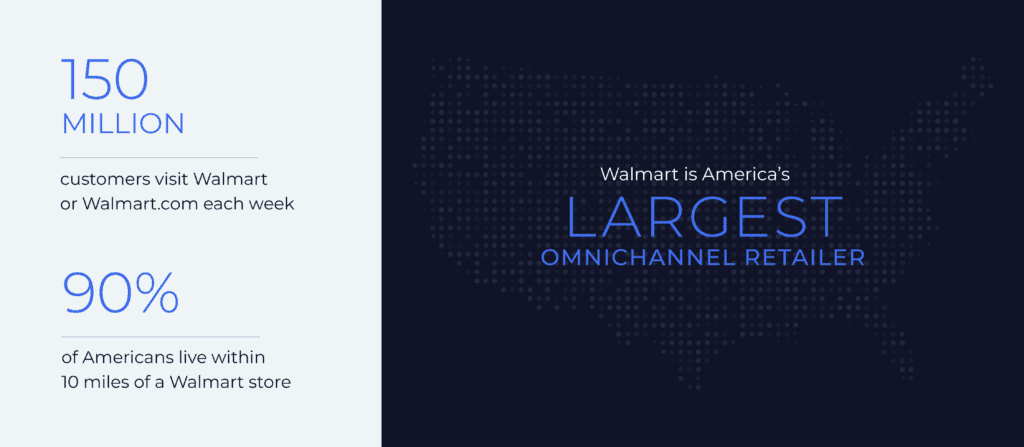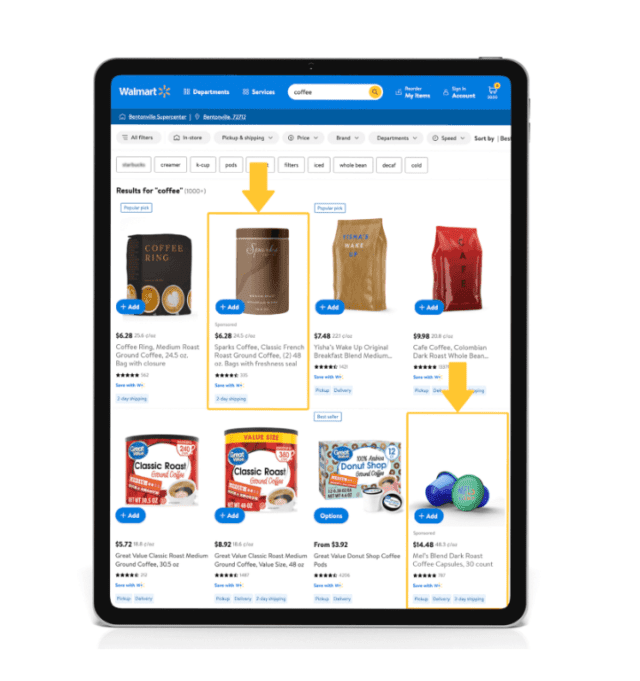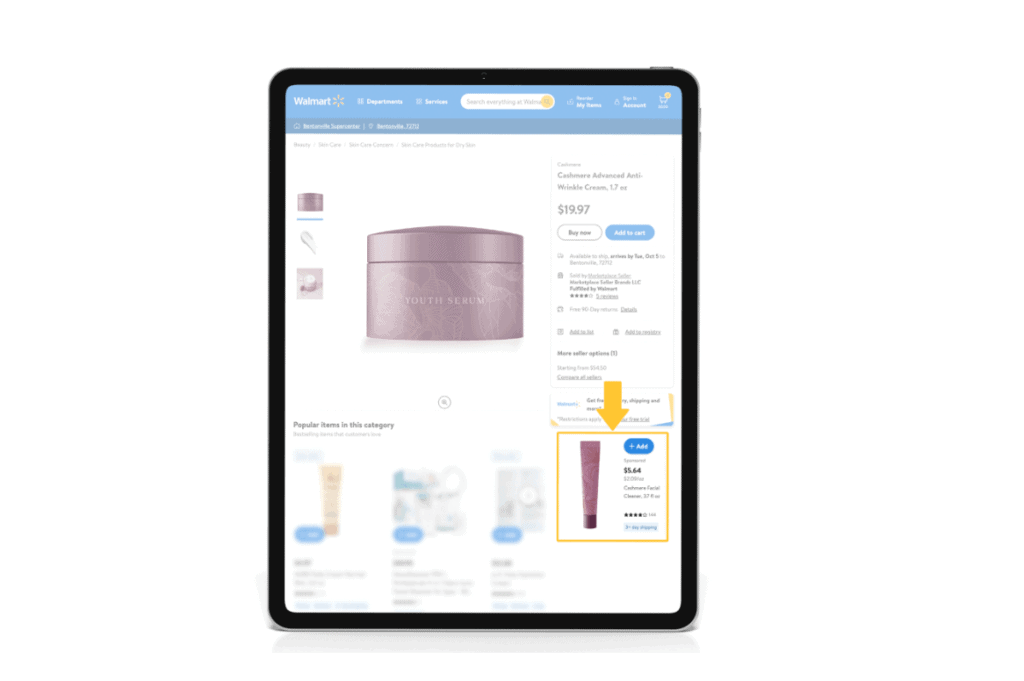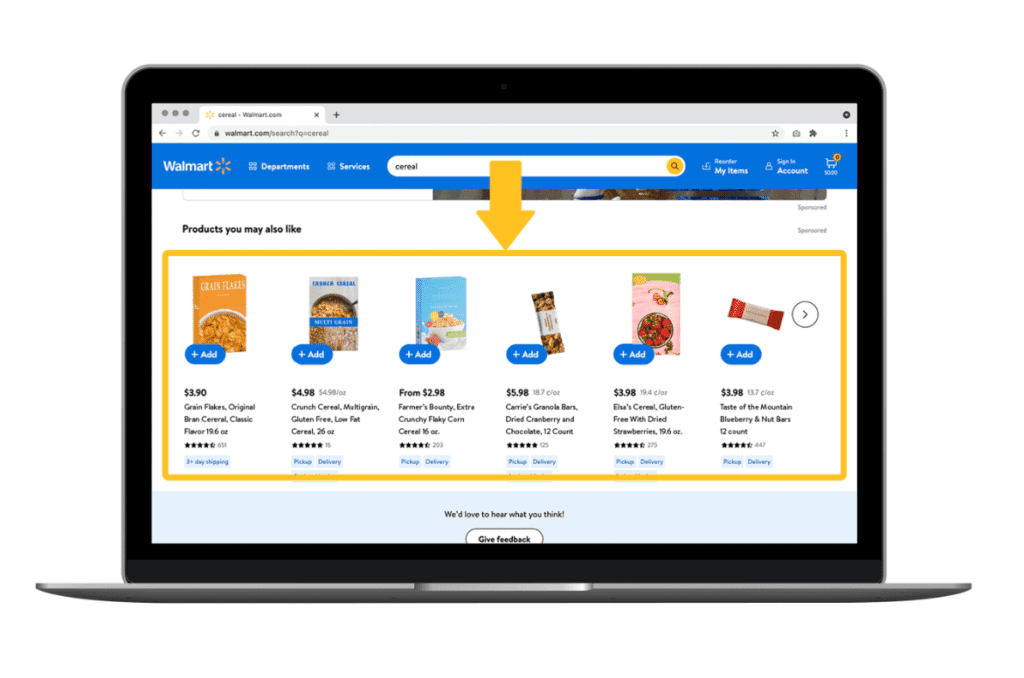
With more ecommerce marketplace options available to third-party sellers than ever before, it can be difficult to determine the best avenue to connect with the most relevant customers and conduct successful sales. From huge companies like Amazon that run the ecommerce landscape, to smaller online retailers making a big name for themselves like Esty, the retail media marketplace competition continues to grow.
In the midst of this spectrum stands a tried-and-true retailer built on a foundation of customer loyalty, in-store sales success, and a rapidly growing, innovative marketplace: Walmart. In this complete guide, we explore what Walmart Advertising is, its benefits, how it works, and how you can start advertising on Walmart, as well as a few of the key differences between advertising on Walmart versus Amazon. You can follow down the blog or jump to a particular section with our table of contents:
TABLE OF CONTENTS
- What Is Walmart Advertising?
- What Are the Benefits of Walmart Advertising?
- How Do Walmart Advertising Campaigns Works?
- How to Create a Strategy For Your Walmart Ads?
- Walmart versus Amazon
- 5 Key Walmart Advertising Innovations
- How to Get Started Selling on Walmart
- How Do I Get Help with Walmart Advertising?
What Is Walmart Advertising?
Third-party sellers can advertise with Walmart by paying for digital advertising space on Walmart.com through Walmart Connect. Walmart’s retail media platform gives sellers access to shoppers online, on the mobile app, and in stores.
As the world’s largest retailer, Walmart reaches over 90% of U.S. households every week. Unlike other ecommerce marketplaces, there are no setup, monthly, or hidden fees associated with signing up or selling products on Walmart Marketplace. Get started with Walmart advertising by completing an application for approval.

Whether you’re selling an enterprise brand or small business, Walmart advertising will provide you with more meaningful ways to connect with customers.
What Are the Benefits of Walmart Advertising?
As the world’s largest retailer, Walmart’s customer reach is reason enough to get your brand on its website. Even so, there are a few other unique reasons you may not have considered:
Brand loyalty. Walmart is turning heads as its online marketplace continues to rapidly grow. A huge factor setting Walmart apart is its above-average customer loyalty, which continuously ranks higher than other leading retailers.
Reach new audiences. Walmart’s customer demographic offers additional benefits for third–party retailers. More than half of Walmart shoppers are homeowners with a medium-high household income; over a third of its online customers are millennials, ages 23 to 38; and Walmart attracts audiences with families, opening doors to varied customer age groups. Lastly, if your products are competitively priced, you could increase your profit by attracting Walmart customers who come looking for a deal.
Flexibility. Walmart’s strength is its brick and mortar locations. As a digital retailer, you may be wondering how that benefits you. The answer: flexibility. At Walmart, customers can shop online, find the product they’re looking for at their local store, and buy it in person if they need the product immediately. It’s also important to remember that relying on one marketplace, like Amazon or eBay, can risk your entire business coming to a halt if something were to go wrong with those sites. Advertising and selling through Walmart allows your business the flexibility to sell online or in store.
How Do Walmart Advertising Campaigns Work?
Before getting into best practices for advertising on Walmart.com, it’s important to understand how it works. Below, we’ve broken down some key terms to understand and remember when advertising through Walmart.
Walmart PPC
As one of the most successful forms of digital marketing, the pay-per-click (PPC) advertising model means that advertisers only pay for the ads that get seen by potential customers. Walmart PPC follows this model and is sold based on keyword bids.
Keyword Bidding
Keyword bidding is when advertisers submit a bid on the highest amount they are willing to pay for a keyword to help secure prime real estate for their display ad. When bidding, they have no knowledge about competitors’ bids and, if the seller wins the auction, they are responsible to pay exactly the bid amount that they submitted.
Let’s break the process down with an example:
A shopper goes to Walmart.com and enters “sheets” into the search bar. They receive more than 1,000 search results for sheets sold at Walmart and only have enough time (and energy) to get through the first three of 25 pages of options. Running a Sponsored Products ad for your sheets and bidding on essential keywords like “sheets,” “soft sheets,” “luxury sheets,” gives you a better chance to have your product right at the top of the search pile — grasping the customer’s attention immediately.
It’s important to prioritize keywords. Depending on your campaign goals and where in the funnel you’re looking to target customers, pay close attention to where your ads are being served. Prioritize bids in premium placements like the Homepage, Search Ingrid, and Stockup to achieve higher frequency and outbid the competition.
What Are Examples of Walmart Ad Types?

Walmart Sponsored Products
Walmart’s type of PPC ad is known as Sponsored Products. Sponsored Products display ads for your product when customers are looking for similar items. By increasing visibility, these ad units help highlight your brand in front of millions of Walmart customers, driving more discovery, sales, and growth as a result. And because they’re pay-per-click ads, you only pay when someone actually clicks on the ad. Walmart Sponsored Products can appear in several different positions within a Walmart search:

Sponsored Products: Search In Grid. Your product is highlighted within the grid of a customer’s search results. It shows up on the first page of results when customers search relevant keywords.
Sponsored Product: Carousel. Your item is highlighted in a shiftable row of multiple items at the top of search, browse, category, or product page. It shows up on results and item pages for similar or relevant products.

Sponsored Products: Buy Box. Your product is highlighted beneath the product details of an item a shopper has clicked on. It shows up in a box ad on its own on results and item pages for similar or relevant products.
Sponsored Search
Walmart Connect Sponsored Search are a search-triggered ad format, but instead of a single product ad within the search results grid, these ad units are more prominent and include your brand logo, a custom headline, and up to four SKUs appear together above relevant search results and include ads that are placed above the search result, with clickable links.

The benefit here is while sponsored product ads are a fantastic way to match a more specific user search directly to a product, Sponsored Search can be used on top-level terms in instances where a shopper is still at the beginning or middle of their research and hasn’t yet zeroed in on the specific item they want to buy.
Reaching users at the top and middle of the funnel allows marketers to insert their brand into the consideration set as consumers figure out which direction they want to take in their purchase journey. It can also build top-funnel awareness that could pay dividends on future purchases.
“We transitioned to a more competitive auction model for sponsored products and search brand amplifier advertising that helped level the playing field for all advertisers, big or small…in this auction, the most relevant product wins the auction and the winner pays only the amount necessary to beat any competing bids. And the good news here is that the amount will never exceed the winner’s maximum bid.”
Dionne Resnik, Leader Product Marketing Manager – Search Ads at Walmart Connect

How to Create a Strategy for Your Walmart Ads
When taking on a new sales venture, it’s important to have a strategy. We’ve mapped out a few best practice tips to help sellers get started on their Walmart advertising strategy:
Budget. To make sure you don’t overspend on your ads, set up a budget you’re comfortable with and commit to it.
Research. Research your competition on Walmart’s website. Search products in your category and see what ads pop up in response to those keywords. Read buyer reviews and learn what the competition is doing well.
Prioritize keywords. Choose the right keywords by putting yourself in the mind of the buyer. Keywords are, well, the key to your campaign’s success. By thinking like a customer, you’ll ensure you choose keywords that are relevant to your products and the target audience.
For example, if you’re selling laundry detergent, what might you type into Walmart’s search bar as a buyer looking for laundry detergent? Think about what specifics your product might have that the buyer would be looking for: “laundry detergent sheets,” “laundry detergent septic safe,” or “laundry detergent cheap.” You may not automatically think of describing your product as “cheap,” but if that’s what the buyer is looking for, it could be an important keyword.
Balance automatic and manual campaigns. While manual campaigns offer more control, giving advertisers the flexibility to add new keywords, match types, and bids automatically, automatic campaigns can be a much simpler option for quickly boosting Walmart Connect PPC ads to the most relevant placements. Consider experimenting with running automatic and manual campaigns simultaneously, with a 30% higher budget on manual to accommodate premium CPCs.
Test your ads. Before making a significant investment, make sure to test your ads to help you determine what is working and what is not.
Walmart versus Amazon
It’s difficult to discuss Walmart Marketplace without also addressing the ecommerce giant that is Amazon. Let’s dive into a few ways Walmart differs from Amazon and how those differences benefit third-party sellers:
Less competition. When it comes to competition, advertising on Walmart.com is significantly less competitive than advertising on Amazon.com. Walmart’s selective application process results in just over 150,000 sellers on their marketplace versus Amazon’s 1.9 billion selling partners worldwide. When a customer is searching your product on Walmart.com, it’s up against a fraction of other retailers when compared to the number of competitors on Amazon.com.
Instore flexibility. Walmart’s in-store presence allows for flexibility that Amazon cannot offer as easily. As previously mentioned, 90% of Americans live in a 10 miles radius of a Walmart. Not only does the retail corporation have the on-land infrastructure to cut fulfillment costs, but it can also more easily store, pack, and deliver food and other consumer goods, and customers can conveniently shop online and pick up in-store. This is a luxury that the majority of Amazon customers do not have, as in-person grocery shopping is only available in select U.S. cities.
Walmart makes it easy on sellers. Walmart doesn’t charge third-party sellers a monthly rate or setup fees (learn more about how to get started selling on Walmart below), compared to Amazon which charges $0.99 per item sold or a flat rate of $39.99 a month. Additionally, after listing your products on Walmart, the company pushes those listings out to its affiliate websites like Shoes.com, Moosejaw.com, and more, allowing your product to reach a larger audience.

5 Key Walmart Advertising Innovations
Although Walmart is behind Amazon in the ecommerce market, with Amazon accounting for 41% of it compared to Walmart’s 6.6%, Walmart is seeing more than 5x the growth in ecommerce than Amazon. If it continues to grow at this rate, Walmart can surpass Amazon’s retail sales in just four years. It’s easy to arrive at the fact that its innovation is the reason why. We’ve broken this section down into Walmat’s five key advertising innovations:
1) Building Trust
Walmart has a unique way of building seller-customer relationships through its Pro Seller Badge system. The Pro Seller Badge is a mark of excellence given to top-performing Marketplace sellers to help them stand out as a reliable choice against the competition. Not only do retailers with a Pro Seller Badge reassure customers of delivery times and quality, but these offers are also designed to be more eye-catching in search results and increase product visibility.
2) Strategic Advertising Placement
Walmart’s calculated approach to rolling out both its marketplace and the advertising layout within it is differentiating Walmart.com from others. Sellers are unable to advertise a product outside of its category, and there is a limit on how many ads appear on a given search results page. These strategies allow for a more curated network of sellers and consistently relevant search pages.
3) Access to In-Store Sales Data
In addition to the multiple benefits of selling products on both Walmart.com and in stores, sellers are also able to track the impact of online Sponsored Product campaigns on in-store sales through the Seller Center on their Walmart account. This feature can be incredibly valuable to sellers when trying to measure the impact of their advertising strategy on Walmart.com.
4) Shopify Integration to Help Sellers
Walmart is obviously working to build a community of reputable third party sellers on its marketplace. As a result, sellers need to prove a history of selling on ecommerce sites, among other requirements, in the application process. In an effort to make selling on Walmart.com more accessible, Walmart partnered with Shopify in 2020 to give direct-to-consumer merchants the opportunity to connect to Walmart Marketplace with ease.
Once established on Shopify with an account, sellers can integrate by simply installing the Walmart Marketplace sales channel from the app store, filling out the application to be a seller, and, once approved, adding the necessary details to products to start selling on Walmart.com.
5) Bid Multipliers
Sellers can increase their chance of securing premium placements for automatic campaigns using bid multipliers. With automatic campaigns, sellers allow Walmart to place their ads where it believes they are the best fit, but bid multipliers give advertisers a little more control of which campaigns they want to prioritize for higher-profile placements.
How to Get Started Selling on Walmart
Unlike other ecommerce marketplaces like Amazon, Etsy, and eBay, there are no setup, monthly, or hidden fees associated with signing up or selling products on Walmart Marketplace. Instead, sellers pay a referral fee of 6-15% on sales, depending on the category of the product. Sellers can get started on Walmart in just a few simple steps:
Initiate the request: Walmart.com has a curated selection of sellers on their site and requires all businesses to complete an application for approval. The application process takes about 10-15 minutes if you have all the necessary information at hand, including:
- US Business Tax ID
- W9 or W8 and EIN Verification Letter
- US Business address
- Planned method for uploading your product catalog (bulk upload, API, solution provider)
- Details about your primary products: categories, catalog size, and related information (e.g. total SKUs you will be selling on Walmart.com initially with verified UPC information, and used vs. refurbished etc.)
It’s important to gather all required information before starting your application, because once you start your application you can’t save it for later and must complete the process from start to finish.
Approval and agreement: Walmart is launching a new “Check Your Status” feature that will allow sellers to do just that: check their application status during the short review period. This feature is designed to give real-time updates and to let sellers know where they stand in the process.
Registration: After approval, you’ll be asked to sign Walmart’s Retailer Agreement and invited to set up your account. To do so, you’ll need:
- Your basic information (contact name, corporate address, bank account details, business information, etc.)
- Shipping information including pricing model, shipping methods, and regions you’re able to ship to.
- Decided integration method for your product catalog (Bulk Upload, API, or solution provider)
- To register with Walmart’s payment providers to receive payments from Walmart
- Information on your listings and related details, such as product category, price, and inventory
How Do I Get Help with Walmart Advertising?
When it comes to building your own Walmart advertising strategy, remember that trial and error is all part of the process and to take it one step at a time. If you need further support as a Walmart seller, it offers a robust knowledge base that includes: seller help guides, Marketplace FAQs, and a categorized support webpage.
We hope this comprehensive guide helps you understand the Walmart advertising platform, but it’s understandable to still feel overwhelmed at the prospect of building your Marketplace strategy and successfully selling your products on Walmart.com.
To capture demand and realize your brand’s growth potential by driving sales on Walmart’s high-traffic properties, reach out to Skai for further support with Walmart advertising.
